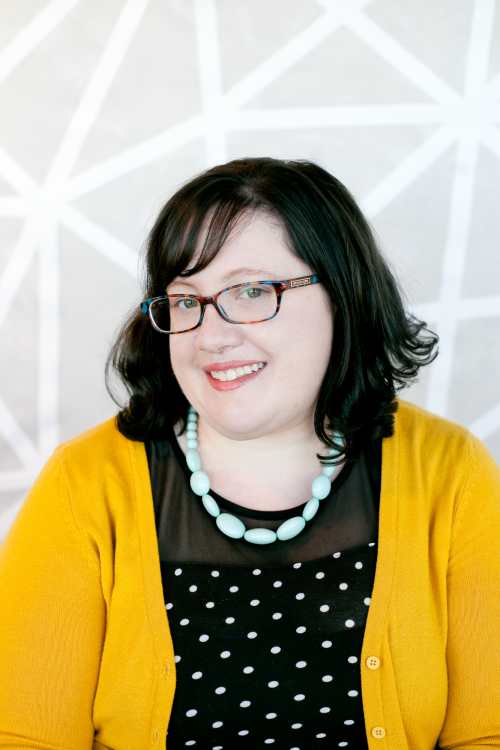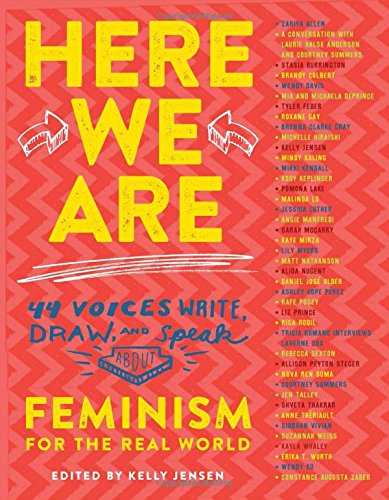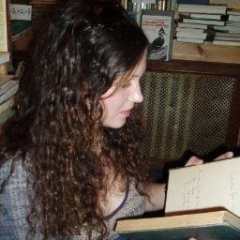Here Come the Feminists: An Interview with Kelly Jensen

These days, it seems counterintuitive to suggest that anything good could come of a tweet, but Kelly Jensen’s new essay collection, Here We Are, trumps that perception brilliantly. It began just that way, with an idea sent out into cyberspace. With contributors ranging from Wendy Davis to Mindy Kaling, and including Foreword’s own reviewer Constance Augusta Zaber, these essays are entertaining, encouraging, and informative, and serve to introduce young readers to feminism in all its breadth, or to encourage them along as they forge their ways within it.
This is hardly Jensen’s first contribution to activism on behalf of diverse communities. As an editor at Book Riot, she encourages rich and varied YA reading, and she draws upon her library knowledge for her blog, STACKED—an excellent resource for anyone looking for recommendations that go beyond the norm. Between projects, she also takes her activism live; recently, she participated in the massive Chicago Women’s March on January 21. Jensen knows that, no matter how monumental the challenges we’re facing, books will have a crucial role to play in the fight, and her activism reflects that.
Kelly Jensen, editor of Here We Are
What inspired your project with Algonquin, Here We Are, and how did it come together?

Kelly Jensen: 'Keep reading, keep writing, and keep standing up for what you believe in.'

My project had been in my head for a long time, and it came together following a tweet, where I mentioned wanting to do an anthology of feminist essays for YA readers. Elise Howard at Algonquin Young Readers reached out to me, and along with Krestyna Lypen, they bought the book after we talked on the phone and I submitted a proposal. So it was somewhat unconventional but in a way that worked out perfectly.
When I submitted my formal proposal, I came up with a list of people I’d like to approach, ranging from dream names to those who I felt confident would be interested (even if they wouldn’t necessarily say yes). I carefully went through the list and approached those who were on it, making sure to balance voices, POVs, backgrounds, and experiences. I wanted a mix of people in and outside the YA world to really give a big look at what “feminism” means.
Can you tell us a bit about the various hats you wear in the reading and writing world?
My first career was in librarianship, but I’ve been writing forever. I was editor-in-chief of my college’s newspaper and editor of the literary journal. I created and edited a newsletter for the students in my library science program. When I finished graduate school, my friend Kimberly Francisco and I teamed up to create a blog that was all about books and reading—something we saw as a way to have better conversations than we did in our formal classes and keep our skills up to date. STACKED grew considerably, and it was from that where I moved to working for Book Riot as a writer, and then a year or so later, coming on as an editor.
Right now my day-to-day is pretty much a dream. I work for a few hours in the morning for Book Riot, then I take the mid-morning/afternoon hours to write and read for my own self (for STACKED, for projects underway, etc.), and then I work for Book Riot again in the evenings.
What was it like working with Algonquin to bring Here We Are to print?
When I got the proof of my cover in in inbox, I e-mailed my editors and my agent with the response of something like “is it okay to say HOLY F^CK? Because HOLY F^CK!” It’s been a dream. Both my editors have been the perfect mix of hands on and hands off—on to take care of business stuff, to edit, and to brainstorm what the book might look like, and off for me to pursue this how I think best to pursue it. The design of the book was beyond anything I could dream of, and it was nice to not even worry or think about that entire side of the project.
The first thing that an Algonquin author said to me when my deal for FEMINISM was made public was “welcome to the family.” And it’s true. Algonquin feels like a family because it’s small and because everyone supports one another.
What would you most like to see more of in young adult literature, and why?
I tell this story every time I get the chance because I think it highlights this question’s answer for me perfectly. In my last library job, there was a moment I was sitting in on a program. I looked around the room and realized I was the only white person in that room. This was in Wisconsin, which people don’t equate with “diverse.” Except, that’s the reality of our world right now.
Yet when you look at the YA shelves, it’s mostly white, with a few stories by and about people of color interspersed. We need more inclusivity in YA lit, both from fiction and nonfiction (which, I think is the one rare place in the YA world where it’s been a bigger, more obvious presence). We need these stories for our kids to see themselves and to see others … and we need them because that’s our world.
You—and several of the other writers who contributed to Here We Are—recently participated in the Women’s March on Washington. Can you tell us, as a reader and a feminist, why this taking this action felt important to you?
I actually marched in Chicago, where the march was canceled because the crowd was something like four times the size of the 50,000 the organizers anticipated. The two hours I was out there was spent on one of the bridges going into Grant Park, and watching people of all genders and all colors coming together because we all want the same thing: equality.
Doing this was important to me, in part because it felt easy. Going out on a nice Saturday (I mean, we likely don’t need to talk about the global warming going on when it’s 60 degrees in Chicago in mid-January) with a friend and her family was easy. But doing that easy thing helps set off a chain reaction of doing more things, some easy, and some much harder. It was incredible to see the youngest of the young and the oldest members of our society coming together over these shared values and beliefs and remembering that’s the why. That’s why we keep fighting.
In the aftermath: where do reading activists go from here (either in reading or in action)?
On a personal level, going micro in focus is what I’m planning to do. Supporting local business as much as possible. Reading books from people who aren’t straight and white and talking about them on the platforms I have. Giving money to teachers through Donors Choose and other places where that money goes directly to another individual or small group that’s impacting change in their own small corner of the world.
In the larger realm: keep reading, keep writing, and keep standing up for what you believe in. Keep challenging the status quo. Don’t back down from your beliefs. Take the time, too, to listen to your fellow humans, including those who voted against everything you hold dearly, including those who believe science is fake and women, queer people, disabled individuals, aren’t allowed the same rights as the cishet Christian white man. You don’t have to believe them, and you don’t have to argue with them. But by listening, you can better strengthen your own cases and maybe find a way to weave your beliefs into change that you didn’t think of before. (Or use the anti-sentiments you hear to funnel energy into funding projects or encouraging people who are doing the things being railed against).
One of the most powerful statements I’ve repeated to myself over the last few years is a simple one, and it’s one that I keep returning to again and again in the wake of a terrifying political world: you know what to do. You know. What. To do.

Michelle Anne Schingler is the managing editor at Foreword Reviews. You can follow her on Twitter @mschingler or e-mail her at mschingler@forewordreviews.com.
Michelle Anne Schingler
